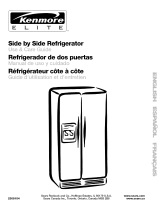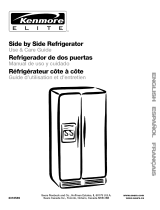
TABLEOF CONTENTS
REFRIGERATOR SAFETY ............................................................. 3
Proper Disposal of Your Old Refrigerator .................................... 3
BEFORE USE .................................................................................. 4
REFRIGERATOR USE .................................................................... 4
Power On/Off Switch ................................................................... 4
Water System Preparation ........................................................... 5
Normal Sounds ............................................................................ 6
Ensuring Proper Air Circulation .................................................... 6
Using Controls .............................................................................. 6
Water and Ice Dispensers ............................................................ 8
Water Filtration System ................................................................ 9
Ice Maker and Storage Bin ........................................................ 10
REFRIGERATOR FEATURES ...................................................... 11
Refrigerator Shelves ................................................................... 11
Ingredient Care Center ............................................................... 11
Crisper and Covers .................................................................... 12
Covered Utility Bin ..................................................................... 12
Wine Rack .................................................................................. 12
FREEZER FEATURES .................................................................. 12
Freezer Shelf ............................................................................... 12
Freezer Basket ............................................................................ 12
DOOR FEATURES ........................................................................ 13
Utility Compartment ................................................................... 13
Door Bins .................................................................................... 13
REFRIGERATOR CARE ............................................................... 13
Cleaning ...................................................................................... 13
Changing the Light Bulbs ........................................................... 14
Power Interruptions .................................................................... 14
Vacation Care ............................................................................. 15
TROU BLESI-IOOTING .................................................................. 15
ASSISTANCE OR SERVICE ......................................................... 18
In the U.S.A................................................................................ 18
In Canada ................................................................................... 18
Accessories ................................................................................ 18
WATER FILTER CERTIFICATIONS ............................................. 18
PRODUCT DATA SHEETS ........................................................... 19
WARRANTY .................................................................................. 20
P
INDICE
SEGURIDAD DEL REFRIGERADOR ........................................... 21
CGmo deshacerse adecuadamente de su refrigerador viejo....21
ANTES BE MSAR .......................................................................... 22
USO DE SU REFRIGERADOR ..................................................... 22
Interrupter de Encendido/Apagado ........................................... 22
PreparaciGn del sistema de agua .............................................. 23
Sonidos normales ...................................................................... 24
CGmo asegurar la debida circulaciGn del aire ........................... 24
Uso de los controles .................................................................. 24
Despachadores de agua y hielo ................................................ 27
Sistema de filtraciGn de agua .................................................... 28
Fabrica de hielo y dep6sito ........................................................ 29
CARACTERiSTICAS DEL REFRIGERADOR .............................. 30
Estantes del refrigerador ............................................................ 30
Centre de cuidado de ingredientes ........................................... 30
Cajones para verduras y tapas .................................................. 31
Compartimiento de uso general con tapa ................................. 31
Portabotellas .............................................................................. 31
CARACTERiSTICAS DEL CONGELADOR ................................. 31
Estante del congelador .............................................................. 31
Canastilla del congelador ........................................................... 32
CARACTERiSTICAS DE LA PUERTA ......................................... 32
Compartimiento utilitario ............................................................ 32
Recipientes de las puertas ......................................................... 32
CMIDADO DE SU REFRIGERABOR ............................................ 32
Limpieza ..................................................................................... 32
CGmo cambiar los focos ............................................................ 33
Cortes de corriente ..................................................................... 34
Cuidado durante las vacaciones ................................................ 34
SOLUCION DE PROBLEMAS ...................................................... 34
AYUDA O SERVICIO TI_CNICO ................................................... 38
En los EE.UU.............................................................................. 38
En Canada .................................................................................. 38
Accesorios .................................................................................. 38
NOJA DE DATOS DEL PRODUCTO ........................................... 39
GARANT|A ..................................................................................... 40
TABLE DES MATIERES
SI_CURITE DU REFRIGERATEUR .............................................. 41
Mise au rebut de votre vieux refrigerateur ................................. 41
AVANT L'UTILISATION ................................................................ 42
UTILISATION DU RI_FRIGI_RATEUR .......................................... 42
Commutateur marche/arr_t ....................................................... 42
Preparation du syst_me d'eau ................................................... 43
Sons normaux ............................................................................ 44
Pour s'assurer d'une circulation d'air appropriee ..................... 44
Utilisation des commandes ........................................................ 44
Distributeurs d'eau et de glagons .............................................. 47
Systeme de filtration d'eau ........................................................ 48
Machine a glagons et bac/seau d'entreposage ........................ 49
CARACTERISTIQUES DU REFRIGI_RATEUR ........................... 50
Tablettes du refrigerateur ........................................................... 50
Centre de soins des ingredients ................................................ 50
Bac a legumes et couvercles ..................................................... 51
Casier utilitaire couvert ............................................................... 51
Casier a vin ................................................................................. 51
CARACTERISTIQUES DU CONGI_LATEUR ............................... 51
Tablette de congelateur ............................................................. 51
Panier du congelateur ................................................................ 52
CARACTERISTIQUES DE LA PORTE ......................................... 52
Compartiment utilitaire ............................................................... 52
Compartiments dans la porte .................................................... 52
ENTRETIEN BU RI_FRIGERATEUR ............................................ 52
Nettoyage ................................................................................... 52
Remplacement des ampoules d'eclairage ................................ 53
Pannes de courant ..................................................................... 54
Entretien avant les vacances ..................................................... 54
DEPANNAGE ................................................................................. 55
ASSISTANCE OU SERVICE ......................................................... 58
Accessoires ................................................................................ 58
FEUILLES BE BONNI_ES SUR LE PROBUIT ............................. 59
GARANTIE ..................................................................................... 60






















